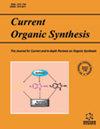过渡金属催化的直接C─芳烃和杂芳烃的硫键合
IF 1.7
4区 化学
Q3 CHEMISTRY, ORGANIC
引用次数: 0
摘要
过渡金属催化C─氢键活化反应是在失活的饱和和不饱和C-H键中引入不同官能团的新兴领域。C─S和C─由于有机硫族试剂在药物化学和材料领域的重要应用,芳香族支架中的硒键构建非常有趣。将硫或硒部分引入惰性C─芳烃在过渡金属催化下的H官能度已成为近年来的主要挑战和目标之一。从这个角度来看,已经广泛研究了各种过渡金属,如Cu、Ni、Co、Pd、Rh、Ru等。具有合适导向基团的芳香芳烃是选择性合成不同取代芳基砜和芳基硫化物/硒化物的最有前途的偶联伴侣。由于产物的区域选择性、底物范围广、反应条件温和和优异的官能团耐受性,合成策略非常方便。当前的综述文章全面总结了C─过渡金属催化C形成S/Se键─在指导基团的帮助下进行氢键活化以控制位点选择性。本文章由计算机程序翻译,如有差异,请以英文原文为准。
Transition Metals Catalyzed Direct C─H Chalcogentaion of Arenes and Heteroarenes
Transition metals catalyzed C─H bond activation reactions have appeared as an emerging field to introduce different functional groups in the inactivated saturated and unsaturated C-H bonds. C─S and C─Se bond constructions in aromatic scaffolds are very interesting due to the important applications of organochalcogen reagents in pharmaceutical chemistry and the material world. The introduction of sulphur or selenium moiety to an inert C─H functionality of an arene under transition metal catalysis has become one of the prime challenges and targets in recent years. In this perspective, various transition metals such as Cu, Ni, Co, Pd, Rh, Ru etc. have been extensively studied. Aromatic arenes owning bearing suitable directing groups appeared as the most promising coupling partners to selectively synthesize differently substituted aryl sulfones and aryl sulfides/selenides. The synthetic strategies were highly convenient owing to the regioselectivity of products, broad substrate scope, mild reaction conditions and excellent functional group tolerance. The current review article comprehensively summarizes the extent of C─S/Se bond formation via transition metal-catalyzed C─H bond activation with the assistance of directing groups to govern the site selectivity.
求助全文
通过发布文献求助,成功后即可免费获取论文全文。
去求助
来源期刊

Current organic synthesis
化学-有机化学
CiteScore
3.40
自引率
5.60%
发文量
86
审稿时长
6-12 weeks
期刊介绍:
Current Organic Synthesis publishes in-depth reviews, original research articles and letter/short communications on all areas of synthetic organic chemistry i.e. asymmetric synthesis, organometallic chemistry, novel synthetic approaches to complex organic molecules, carbohydrates, polymers, protein chemistry, DNA chemistry, supramolecular chemistry, molecular recognition and new synthetic methods in organic chemistry. The frontier reviews provide the current state of knowledge in these fields and are written by experts who are internationally known for their eminent research contributions. The journal is essential reading to all synthetic organic chemists. Current Organic Synthesis should prove to be of great interest to synthetic chemists in academia and industry who wish to keep abreast with recent developments in key fields of organic synthesis.
 求助内容:
求助内容: 应助结果提醒方式:
应助结果提醒方式:


